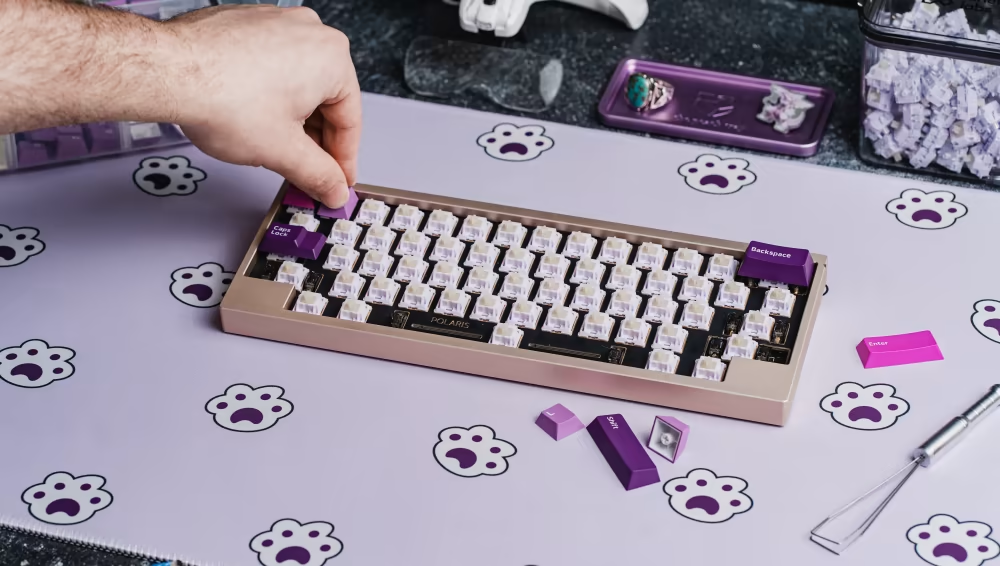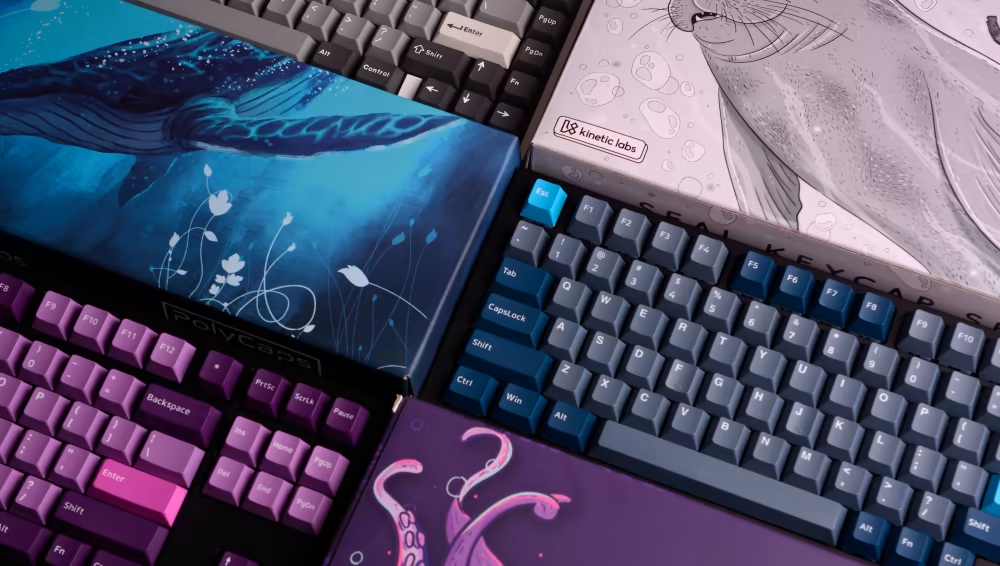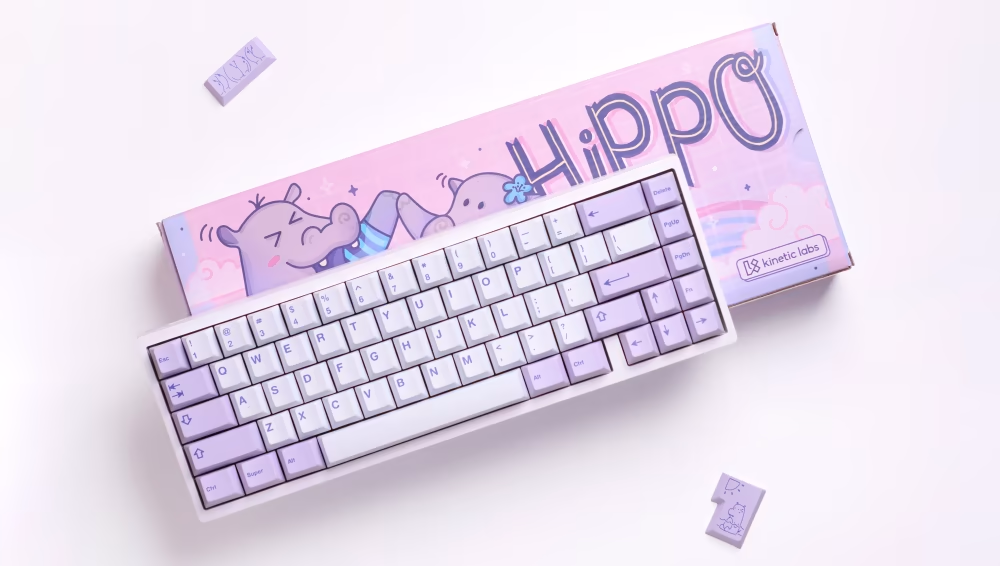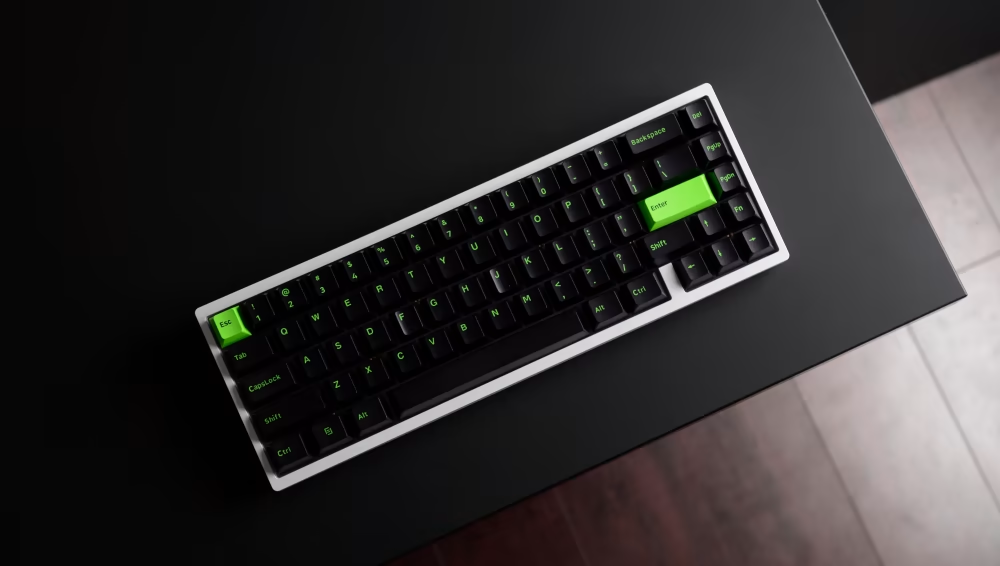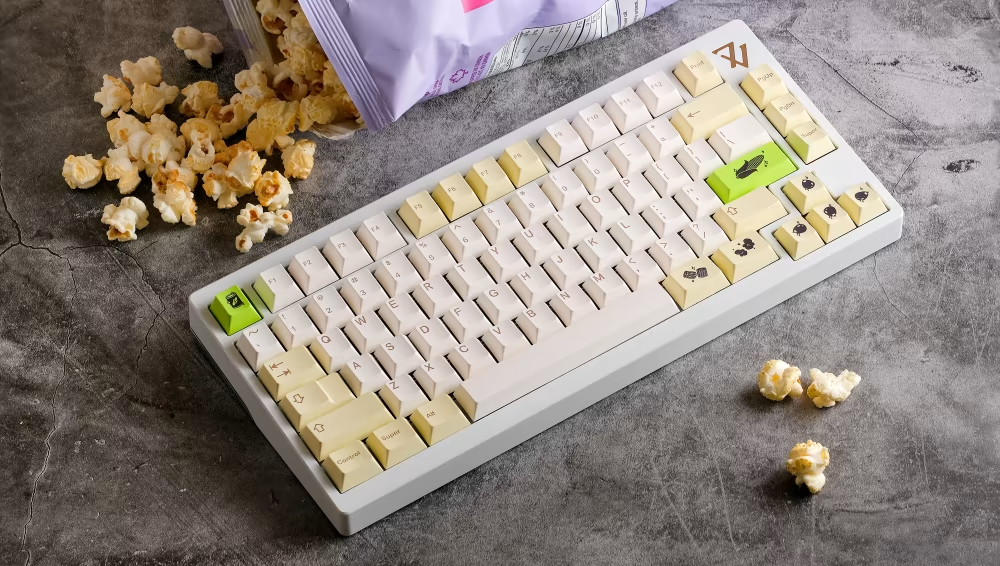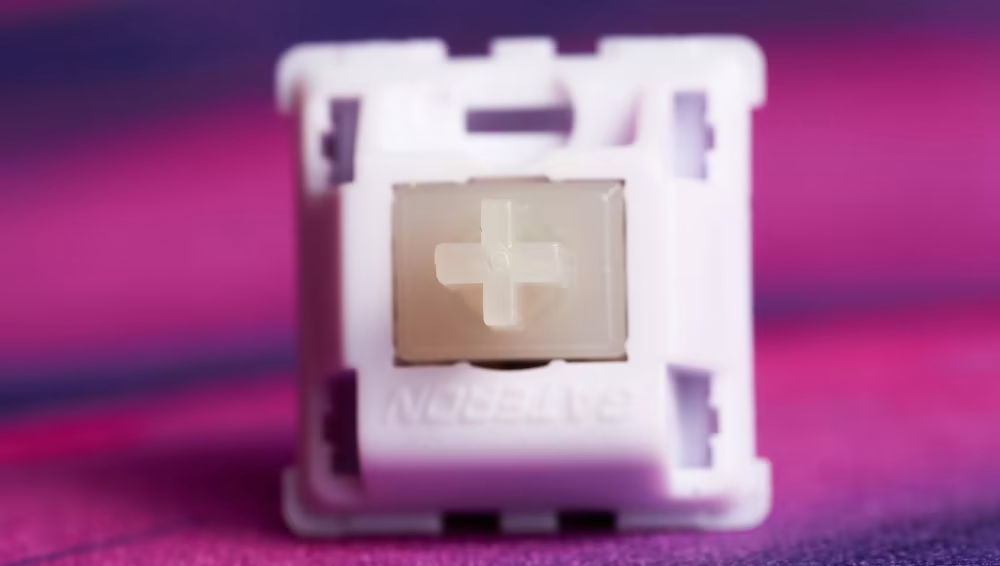PolyCaps Whale and Sea Dreams Mat In the wonderful world of custom mechanical keyboards, typing feels good, and gaming is even more fun because the keyboards are more tactile and tailored to your needs. This explains why most tech workaholics and game addicts have a deep affection for mechanical keyboards. While custom mechanical keyboards can take your typing and gaming experience to the next level, it's costly to get one of these bad boys on your desk. They can easily reach $500+. Their higher pricing than ordinary keyboards makes you wonder: Let's start with the basics. As the name suggests, a custom mechanical keyboard allows you to tailor it to your needs. You can customize it in many ways besides replacing the keycaps. For example, you can customize how heavy it should be and the general design. In short, you can personalize the following components in a custom mechanical keyboard: If you are a first-timer in building a custom keyboard, some companies sell "barebones" kits that include the PCB, plate, and body. If you are tech-savvy, some kits allow you to buy keyboard parts separately and assemble them yourself. This allows you to create a truly custom keyboard you are proud of because it may be one of a kind. However, it will cost you an arm and a leg to have a custom keyboard on your desk. Here are the reasons why custom mechanical keyboards are so expensive. There are dozens of reasons why these keyboards are costly. But here are the top six. Installing Hippo Linear Switches Custom mechanical keyboards stand true to their name. You can easily replace components with what suits you best. The customization goes beyond switching your keycaps for something more colorful or comfortable. You personalize how your keyboard sounds. As a result, you become the master of your typing and gaming experience. Apart from the sound, you can customize the number of keys on your keyboard and how hard you have to press them before they respond. You can even remap the entire keyboard by changing the default functions of keys and assigning them entirely different tasks. Depending on the extent of your customization, you can tailor the keyboard's looks, the function of each key, and most importantly—the "click-clack" sounds when typing or gaming. A custom mechanical keyboard may be expensive, but you can make it look and sound unique the way you like. This degree of customizability leads to a higher cost because your keyboard components are specialized and will be manufactured by smaller specialty factories. PolyCaps Keycap Sets Designing custom keyboard circuits and architecture can be time consuming, and can take several rounds of prototyping small runs. In the most extreme cases it takes a small group of experienced experts who hand-assemble the components for the keyboard until a perfect prototype is reached. Custom mechanical keyboards are currently manufactured on a small scale for a limited niche market. Although it can feel large at times, most successful group buy keyboards have sales in the hundreds, which is a drop in the bucket compared to the more general mechanical keyboard market. The demand for these keyboards is relatively small, so manufacturers haven't set up large-scale production units, which increases the overall production cost. Manufacturers push these costs to their selling prices, making custom mechanical keyboards expensive. Hippo Themed Keyboard Build One main reason custom keyboards are costly is their high-quality production standards. Brands conduct quality tests and inspections on components to ensure they create a high-quality product. Some of the high-quality components in these keyboards include: Specialty switches are one of the main reason enthusiasts prefer mechanical keyboards to membrane keyboards. As the name suggests, you can easily replace custom switches with ones that suit your needs. Everything from ortholinear, 40s, 65%, 67%, to 100% and everything in between gives the enthusiast market a large pool of limited-run options. Common keyboard cases for custom mechanical keyboards include aluminum, plastic, and even brass (yes, a keyboard made completely of brass!). Custom keyboards with brass and aluminum cases are usually more expensive than those with plastic cases because of their robustness. Although even small runs of CNC-d plastic can be expensive due to the complexity of CNC-ing plastic. As a result, you can easily press these keys to improve your typing and gaming experience. Depending on how quiet you want your keys to be, you can replace the stabilizers with better alternatives whenever you like and tune them using greases such as Krytox 205g0. Additional materials include steel, brass, carbon fiber, plastic, and aluminum. Depending on the type of keyboard you use, the quality of the material utilized in these plates will vary. Manufacturers spend a reasonable amount of money on these components to ensure you get a high-quality custom keyboard. If you don't joke with quality, a custom plate mode of a quality material is an excellent investment, even if it's expensive. Build with PolyCaps Code As a keyboard enthusiast, you want a product that can stand the test of time. Well, you may pay a high price for a custom mechanical keyboard, but you get durability in return. Custom keyboards can last for many years—this shouldn't be a surprise. Better build structure, high-quality standards, and reliable components are some of the greatest features of custom keyboards. For example, aluminum and brass casings (common in custom mechanical keyboards) are more robust than plastic (common in regular keyboards) for durability. Additionally, switches in a custom mechanical keyboard are incredibly long since each key relies on its individual switch. According to factory specification sheets from both Cherry and Gateron, a custom mechanical keyboard switch can withstand millions of keystrokes before breaking. Traditional keyboards don't offer such durability, which explains the high price of mechanical keyboards. PolyCaps Code Keycaps Custom keyboards provide a streamlined user experience. They are purposely designed to simplify typing and gaming for people using them. The keycaps and switches respond quickly, making it easy to press a button. Depending on the type of switch, a custom keyboard may fasten your typing speed because the keys register strokes faster—less force is necessary for each stroke. On the flip side, you can use an extremely heavy switch (i.e. by swapping in 150g Symmetric Springs) This is one more reason custom mechanical keyboards are superior to regular keyboards, making them more expensive. Honestly, a custom mechanical keyboard has exciting perks, but it's not for everyone. If you have a very tight budget, this hobby may not be for you. The average cost of building a custom keyboard ranges between $200–$400 and can even go beyond $500. The devil is in the details. The exact price depends on how extensively you want to customize the keyboard. Additionally, a custom keyboard may not be suitable for you if you don't have enough time to put in the effort. Building a custom keyboard is a process. For example, it takes time to find the right parts you like, and assembling them is another process. Generally, if time and money are a big issue, building a custom keyboard might not be for you. But if you are an enthusiast willing to put in the effort and you are not on a tight budget, read on to find out if these keyboards are worth their high price. Close-up Hippo Switch Building a genuinely personalized keyboard have dozens of aspects that can generally turn away light-hearted first-timers. Plus, the whole process involves a lot of money that many people may find difficult to spend on a keyboard. So the big question is, are custom mechanical keyboards worth it? Yes, they're worth it! A custom mechanical keyboard is all about what you want and making it suitable for your needs. If you find production keyboards unsatisfactory such that they compromise your preferred design and typing experience, a custom mechanical keyboard is worth the money. Custom keyboards give you massive control over all aspects that matter most in a keyboard—design, click-click sound, how fast the keys should respond in every stroke, and the casing material. As long as you understand what you are looking for, a custom mechanical keyboard is worth the effort and money. Whether you want a mechanical keyboard for work or casual play, a custom keyboard is your best bet for luxury, visual appeal, and owning a one-of-kind product (it actually might be your unique masterpiece in the entire universe). That's because you can customize every aspect to your liking. Maybe you're sick of your current keyboard. Or perhaps you broke your old "baby," and now the keys are stuck and don't work anymore. In that case, building your keyboard will help you create something unique and creative to express your personality. You will tailor the keyboard to your needs and create something outstanding—no one else in the entire world will have a keyboard like yours. Start building it right now because it is worth the price and extra effort. Need help building your custom keyboard? Check out the Kinetic Labs full line-up of items to help you achieve the setup of your dreams! Want more personalized help? The support team at Kinetic Labs is always happy to chat. Contact Us. How does TFT work? Tft Lcd Module,Lcd Liquid Crystal Display Module,Lcd Module,Lcd Screen Module ESEN Optoelectronics Technology Co., Ltd, , https://www.esenlcd.comWhat is a custom mechanical keyboard?
Top 5 reasons why custom mechanical keyboards are expensive
1. High customizability
2. High manufacturing costs
3. High-quality keyboard components and build materials
4. Custom mechanical keyboards are long-lasting
5. Better user experience than regular keyboards
Are custom mechanical keyboards for everyone?
Are custom mechanical keyboards worth it?
Build your own custom keyboard to stand out from the crowd
TFT is the abbreviation of "Thin Film Transistor", generally refers to thin film liquid crystal displays, but actually refers to thin film transistors (matrix)-can "actively" control each independent pixel on the screen, which is The origin of the so-called active matrix TFT (active matrix TFT). So how exactly is the image produced? The basic principle is very simple: the Display Screen is composed of many pixels that can emit light of any color, and the purpose can be achieved by controlling each pixel to display the corresponding color. In TFT LCD, backlight technology is generally used. In order to accurately control the color and brightness of each pixel, it is necessary to install a shutter-like switch after each pixel. When the "blinds" are opened, light can pass through, and " When the shutters are closed, light cannot pass through. Of course, technically, it is not as simple as the one just mentioned. LCD (Liquid Crystal Display) utilizes the characteristics of liquid crystals (liquid when heated, and crystallized into solid when cooled). Generally, liquid crystals have three forms:
Smectic liquid crystal similar to clay
Nematic liquid crystal resembling a fine matchstick
Cholestic liquid crystal
The liquid crystal display uses filaments, and when the external environment changes, its molecular structure will also change, and thus have different physical properties-it can achieve the purpose of letting light through or blocking light-which is just like the blinds just now.
Everyone knows the three primary colors, so each pixel on the display screen needs three similar basic components described above to control the three colors of red, green, and blue respectively.
The most commonly used one is twisted nematic TFT LCD (Twisted Nematic TFT LCD). Existing technologies vary greatly, and we will cover them in detail in the second part of this article.
There are grooves on the upper and lower layers. The grooves on the upper layer are arranged longitudinally and the grooves on the lower layer are arranged horizontally. When no voltage is applied to the liquid crystal in its natural state, the light emitted from the light emitting layer of the twisted nematic TFT Display working principle diagram of Figure 2a will be twisted by 90 degrees after passing through the interlayer, so that it can pass through the lower layer smoothly.
When a voltage is applied between the two layers, an electric field is generated. At this time, the liquid crystals are aligned vertically, so the light will not be twisted-the result is that the light cannot pass through the lower layer.
(2) TFT pixel structure: The color filter is divided into red, green, and blue according to the color, which are arranged on the glass substrate to form a group (dot pitch) corresponding to a pixel. Each monochromatic filter is called It is a sub-pixel. In other words, if a TFT display supports a maximum resolution of 1280×1024, then at least 1280×3×1024 sub-pixels and transistors are required. For a 15-inch TFT display (1024×768), then a pixel is about 0.0188 inches (equivalent to 0.30mm), for an 18.1-inch TFT display (1280×1024), it is 0.011 inches (equivalent to 0.28mm) .
As we all know, pixels are decisive for the display. The smaller each pixel is, the larger the maximum resolution that the display can achieve. However, due to the limitation of the physical characteristics of the transistor, the size of each pixel of the TFT at this stage is basically 0.0117 inches (0.297mm), so for a 15-inch display, the maximum resolution is only 1280×1024.
November 20, 2024

